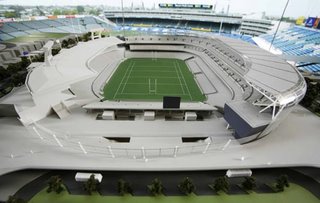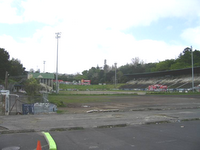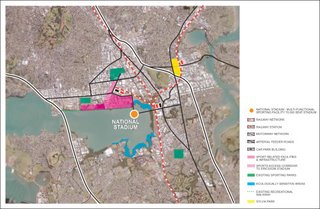under the mountain, over the water
It's game on - so to speak - in the race to decide where to play the final match of the 2011 Rugby World Cup. In the pursuit of a single game of rugby - albeit a very important game - the government charmed the pants off the IRB, promising to rebuild Eden Park to bring it up to scratch for the final. Out of the woodwork though, new proposals for stadia have springed up, variously hailing their location as superior to leafy Mt Eden.
Left now in the hands of whatever politician wants to pay for it, the cards are on the table. But with no formal public consultation process on what we think it the best option for the stadium, no place to vent our praise or frustration at whats on offer, who knows what we'll end up with. Maybe the majority of Aucklanders want a mutli-billion dollar stadium floating off the shores of Remuera, and are prepared to pay for it, but nobody would know because they haven't properly asked anyone.
For now, you'll have to do with my efforts to bring together the various options.
Eden Park Upgrade Envisioned for the current site of Eden Park is a $320 million upgrade of the park, including new stands to take a total of 60,000 people, 38000 of whom can enjoy their favourite sport undercover. The plan will enhance the facility for patrons and neighbours alike - with areas for people to stuff around before and after the game, linking the park with Kingsland railway station before and after the game. Plus the new stands will do a better job of containing light and noise spill (if only they could keep the helicopter quiet as it circles the park). Not to mention a pretty entrance from Sandringham Road
Envisioned for the current site of Eden Park is a $320 million upgrade of the park, including new stands to take a total of 60,000 people, 38000 of whom can enjoy their favourite sport undercover. The plan will enhance the facility for patrons and neighbours alike - with areas for people to stuff around before and after the game, linking the park with Kingsland railway station before and after the game. Plus the new stands will do a better job of containing light and noise spill (if only they could keep the helicopter quiet as it circles the park). Not to mention a pretty entrance from Sandringham Road

Cost: $320 million
Pros: Cheap(!), does the job, improves existing site, railway station adjacent.
Cons: Not 'visionary', very little parking, poor motorway access, seats not very close to stadium, no roof, limited amount of fixtures per year, suburban area.
Pictures: Eden Park Website.
Bledisloe Wharf / Tank Farm
No pretty designs yet, but the stadium by the water idea has captivated the government as worth of consideration. Potentially the crowning jewel on Auckland's waterfront, the design will be a very hot issue, lest it turn out to look like Wellington's Cake Tin. Sydney hit a winner with their Opera House, so there is no reason for us not to be able to do it. So long as it's not designed by committee. Te Papa was panned as a monstrosity when it opened, but today looking at it (and surrounds), it really is a striking building that seems to feel at home in Wellington.
Either site potentially will provide a bookend to a rejuvenated waterfront area, placing much needed fireworks up the ARC and City Council to get on and turn the area into a place of civic pride. I'm not holding my breath, however.
Being a greenfields development, the stadium can also be whatever we want it to be. We can forget dithering around with boring design constrained by existing facilities and build a stadium with all the bells and whistles that a millionaire city deserves.
Cost: Hopefully less than $1billion.
Pros: Exciting opportunity to do something bloody fantastic for the City, away from suburbia, it can have a roof, host wider variety of events more frequently, close to Brittomart.
Cons: $$$$, getting it done in time.
Carlaw Park City Councillor Richard Simpson recently corresponded with RB around using the dilapidated Carlaw Park, at the city edge of the Domain, for the stadium. His surprisingly passionate PowerPoint, outlines his vision for the park.
City Councillor Richard Simpson recently corresponded with RB around using the dilapidated Carlaw Park, at the city edge of the Domain, for the stadium. His surprisingly passionate PowerPoint, outlines his vision for the park.
This is my favourite for the stadium, practically being a greenfields site, having the best potential for public transport and greater use as a multi site venue.
As Cr. Simpson points out, if it's covered the Carlaw Park option can serve as a wet weather alternative for activities in the Domain.
I'd go further and insist that if we were to build a stadium here, it'd have to be covered - partly because if we don't cover the next stadium we build, Auckland will never have a covered stadium of it's size, partly because it rains all the time here and partly because Parnell residents are close by, and having this as a concert venue would rock.
And carparks... lots of lovely carparks to use when vising the Domain, Parnell and the University. Carlaw park has this over most of the other locations around - it and it's facilities will be used 7 days a week by Aucklanders of all persuasions. Eden Park wont.


Cost: ???, possibly up to $1b
Pros: Great use of crappy area, close to SH16 and railway network, close to CBD
Cons: $$$$, getting it done in time.
Images: Cr. Richard Simpson & wises (via Public Address)
Stadium Over Water This has to be the most visionary of proposals yet. It has style, it has viable public transport options, it has longevity, and it has oodles of space. The elegant design of the stadium really is something we can admire, and can admire in 50 or 100 years. Even if this isn't the site, the architects who came up with the plan must be the architects to design the new stadium.
This has to be the most visionary of proposals yet. It has style, it has viable public transport options, it has longevity, and it has oodles of space. The elegant design of the stadium really is something we can admire, and can admire in 50 or 100 years. Even if this isn't the site, the architects who came up with the plan must be the architects to design the new stadium.
Peter Bossley and Bary Copeland - the pair behind the plan - are touting their proposal as a National Stadium, and setting their sights high to match.
If I didn't have a fondness for Central Auckland, this would definitely be my favourite.

They key advantages, according to the pair are:
- The site over water is a “blank canvas.” ... does not have to be purchased, existing facilities demolished, or the impact considered on surrounding buildings;They also put their case forward in the Herald, outl
- It is close to a major transport corridor, with easy access to rail, motorways and Auckland International Airport;
- It is close to one of the fastest growing regions in Auckland: Counties and Manakau
- The close proximity to major transport connections and the relative lack of site restrictions will assist with the intended completion of the purpose-designed world class stadium in time for the Rugby World Cup in 2011.
Sunlight reflecting off the sea would animate the sloping sides of the bowl, making it an object of great beauty and lightness. Artificial lighting would make it a dramatic object appearing to float over the water.

Cost: ???
Pros: Visionary, close to SH1 and railway network, potential to grow desp
Cons: $$$$, away from city, tsunami prone.
Images: (via Scoop)
North Harbour Stadium
Mostly called for by reis
Cost: $200-250m.
Pros: Lots of space for development, less residents, motorway adjacent.
Cons: Too far from Mana
Mt Smart
Again, has no serious push behind it. Shares most of the cons of Mt Eden and North Harbour, without taking too many of the pros. Current stad
Avondale Racetrack
Ditto, plus they have those horrible spiders.
Victoria Park
Or, we could sober up and not.
As we wait for the Government to make up it's mind, we'll just have to twiddle our thumbs and hope they come up with something good.

 e-mail
e-mail


